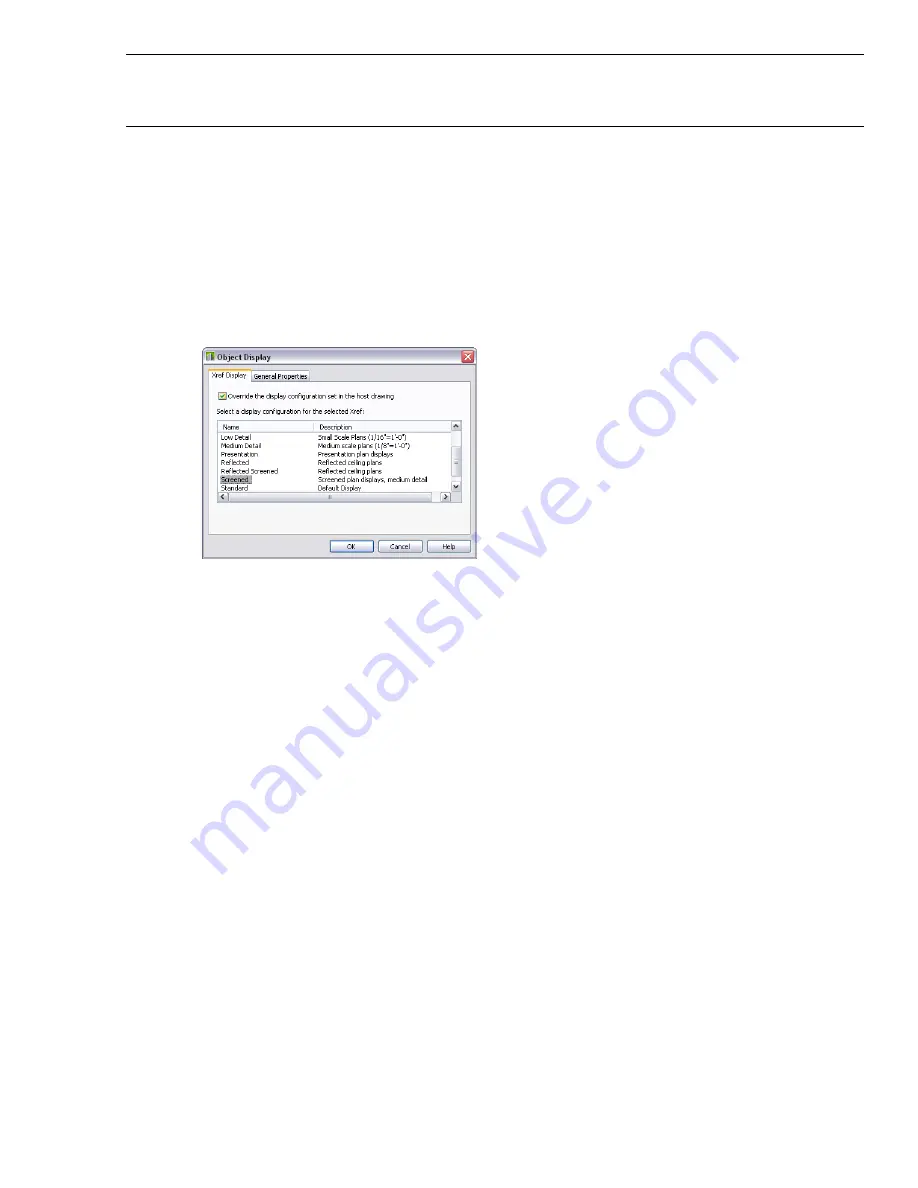
NOTE If you specified that the drawing should always use its own display configurations when inserted as an xref overlay,
you cannot change the display configuration used to display the xref objects in the host drawing. For more information, see
“
Specifying the Display Configurations Used in Xref Overlays
” on page 471
.
1
Open the host drawing that contains the xref drawing for which to specify a different display configuration.
2
Select the xref drawing you want to change, right-click, and click Edit Object Display.
3
Click the Xref Display tab.
If the settings on the tab are unavailable, you cannot change the display configuration used for this xref
overlay.
4
Select Override the display configuration set in the host drawing.
5
Select the display configuration that you want to use.
Selecting a display configuration from those in the xref drawing
The list of display configurations are those available in the xref drawing. Select Drawing Default if you
want to use the default display configuration specified in the host drawing.
6
Click OK.
7
Enter rea (Regenerate All) to see the changes to the display of objects in the xref drawing.
Displaying Objects by Classification
Use this procedure to hide or show objects in a display set based on the classification of the objects. For example, if
you classify objects by construction status (new, existing, or demo), you can exclude objects with the demo classification
from the display. When the display is used in the drawing, those objects do not appear.
Objects filtered from the display are not removed from the drawing. Their display is turned off only in viewports using
the display set in which they are filtered. You can change the filter to display them again. Because the objects still exist
in the drawing, the display of other objects does not change. For example, if you filter doors from a floor plan, the
walls in which they are placed are still cut in the space occupied by the doors.
For more information about defining classifications and assigning them to object styles, see “
Classification Definitions
”
on page 2096.
1
On the Format menu, click Display Manager.
2
Expand Sets.
3
Select the display set you want to edit.
4
Click the Display Options tab.
The classification filter lists all classifications in the current drawing. All classifications are selected by
default.
5
To hide objects of a specified classification, clear the check box under Classification Filter.
For example, to hide all doors and walls classified as A1010 and A1020, clear the check boxes for A1010
and A1020 under Uniformat II.
472 | Chapter 10 Display System
Summary of Contents for 00128-051462-9310 - AUTOCAD 2008 COMM UPG FRM 2005 DVD
Page 1: ...AutoCAD Architecture 2008 User s Guide 2007 ...
Page 4: ...1 2 3 4 5 6 7 8 9 10 ...
Page 40: ...xl Contents ...
Page 41: ...Workflow and User Interface 1 1 ...
Page 42: ...2 Chapter 1 Workflow and User Interface ...
Page 146: ...106 Chapter 3 Content Browser ...
Page 164: ...124 Chapter 4 Creating and Saving Drawings ...
Page 370: ...330 Chapter 6 Drawing Management ...
Page 440: ...400 Chapter 8 Drawing Compare ...
Page 528: ...488 Chapter 10 Display System ...
Page 540: ...500 Chapter 11 Style Manager ...
Page 612: ...572 Chapter 13 Content Creation Guidelines ...
Page 613: ...Conceptual Design 2 573 ...
Page 614: ...574 Chapter 14 Conceptual Design ...
Page 678: ...638 Chapter 16 ObjectViewer ...
Page 683: ...Designing with Architectural Objects 3 643 ...
Page 684: ...644 Chapter 18 Designing with Architectural Objects ...
Page 788: ...748 Chapter 18 Walls ...
Page 942: ...902 Chapter 19 Curtain Walls ...
Page 1042: ...1002 Chapter 21 AEC Polygons ...
Page 1052: ...Changing a door width 1012 Chapter 22 Doors ...
Page 1106: ...Changing a window width 1066 Chapter 23 Windows ...
Page 1172: ...1132 Chapter 24 Openings ...
Page 1226: ...Using grips to change the flight width of a spiral stair run 1186 Chapter 25 Stairs ...
Page 1368: ...Using the Angle grip to edit slab slope 1328 Chapter 28 Slabs and Roof Slabs ...
Page 1491: ...Design Utilities 4 1451 ...
Page 1492: ...1452 Chapter 30 Design Utilities ...
Page 1536: ...1496 Chapter 31 Layout Curves and Grids ...
Page 1564: ...1524 Chapter 32 Grids ...
Page 1611: ...Documentation 5 1571 ...
Page 1612: ...1572 Chapter 36 Documentation ...
Page 1706: ...Stretching a surface opening Moving a surface opening 1666 Chapter 36 Spaces ...
Page 1710: ...Offsetting the edge of a window opening on a freeform space surface 1670 Chapter 36 Spaces ...
Page 1956: ...1916 Chapter 42 Fields ...
Page 2035: ...Properties of a detail callout The Properties of a Callout Tool 1995 ...
Page 2060: ...2020 Chapter 45 Callouts ...
Page 2170: ...2130 Chapter 47 AEC Content and DesignCenter ...
Page 2171: ...Other Utilities 6 2131 ...
Page 2172: ...2132 Chapter 48 Other Utilities ...
Page 2182: ...2142 Chapter 51 Reference AEC Objects ...
Page 2212: ...2172 Chapter 52 Customizing and Adding New Content for Detail Components ...
Page 2217: ...AutoCAD Architecture 2008 Menus 54 2177 ...
Page 2226: ...2186 Chapter 54 AutoCAD Architecture 2008 Menus ...
Page 2268: ...2228 Index ...














































